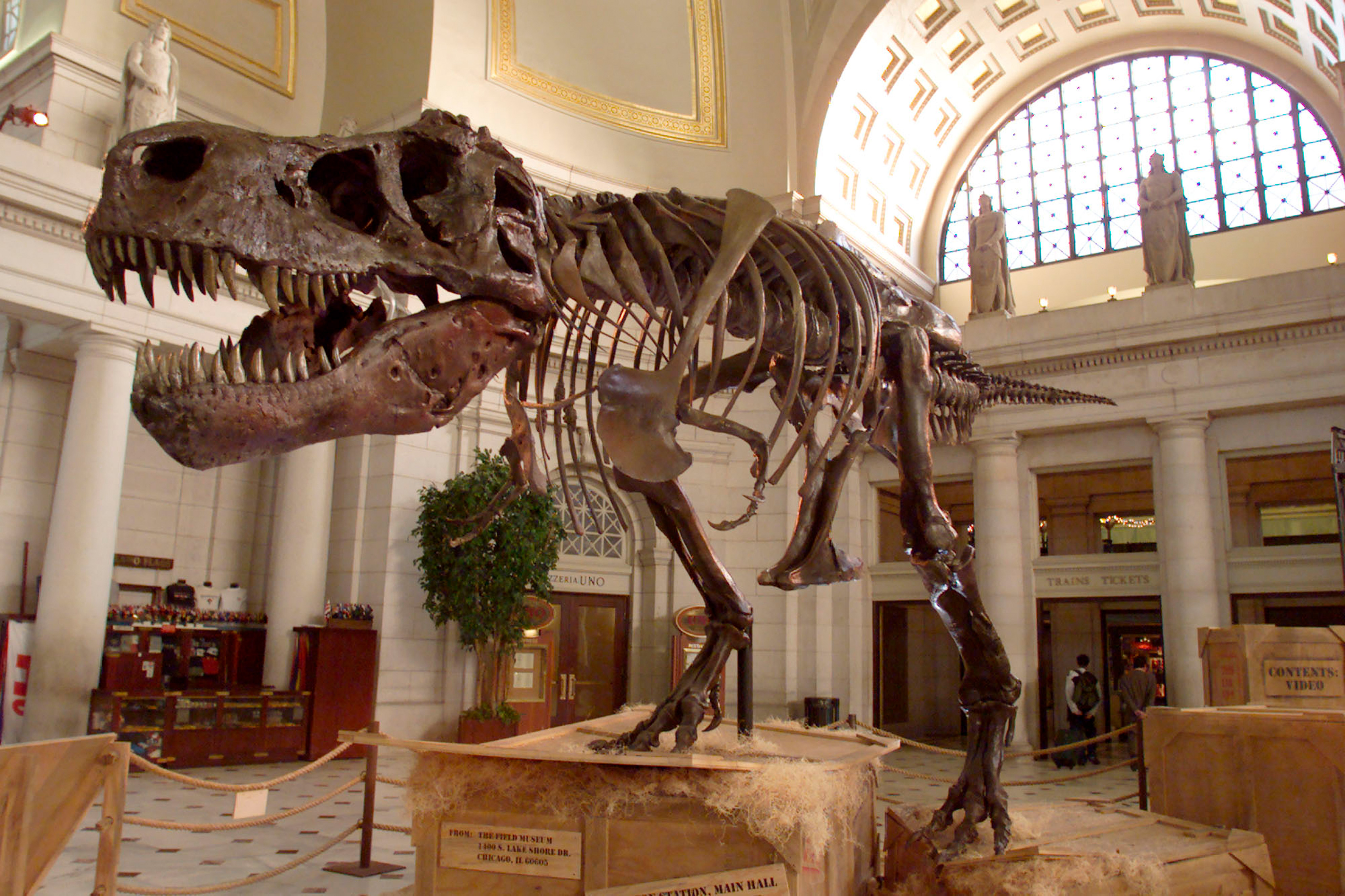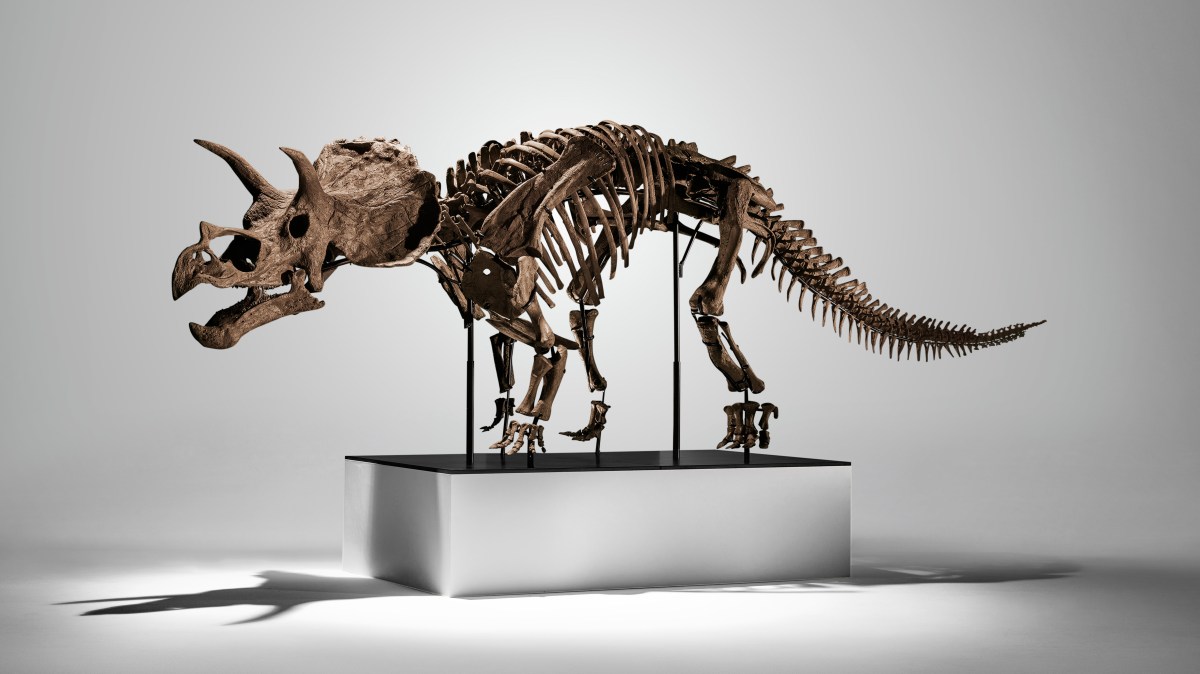If the word thunderbolt conjures up images of the celestial weapons forged by the Cyclopes for Zeus to hurl at the Titans to gain omnipotence, you may be surprised to hear that it will shortly be possible to bid for one.
On the evening of November 18, Phillips New York will auction a zigzag-shaped nugget of crystallised gold measuring almost 50cm long and weighing 117.5 troy ounces (or 3.65kg of 24-carat gold) in Out of This World, a dedicated natural-history section within its autumn sale of modern and contemporary art.
The rare gold nugget, formed of crystal twins that have grown according to the Spinel Law to produce a sculptural stem with leaf-like dendritic plates, is estimated to be worth $1.5-$2 million. It’s not the top lot in the sale, however. That honour goes to a near-complete 4.3m-long juvenile triceratops skeleton (estimate $2.5-$3.5 million); the animal is thought to have been three or four years old when it died 66 million years ago in South Dakota. Both the nugget and the triceratops, with its three horns and distinctive bony frill, will be available to view at the Phillips showrooms at 432 Park Avenue from November 8.

The thunderbolt, a zigzag-shaped nugget of crystallised gold, on sale at Phillips
Natural-history auctions are nothing new — Sotheby’s sold a Tyrannosaurus rex called “Sue” for $8.3 million in 1997 — but this will be the first time Phillips has auctioned such rare and extraordinary objects alongside works of 20th and 21st-century art. According to Miety Heiden, the auction house’s head of private sales, the new departure reflects a “growing appetite for one-of-a-kind treasures” on the part of today’s global collectors. “They seek the unexpected,” she says.
Christian D Link, the Swiss expert Phillips has partnered with for the sale, talks of a “new era” in the collecting world. “There’s definitely a before and after ‘Stan’,” he says, referring to the 12.2m-long, 67-million-year-old T. rex sold at Christie’s in 2020 for $31.8 million — the record for an auctioned fossil at the time. That record was broken in July 2024, when an 8.2m, 150-million-year-old stegosaurus called “Apex” went for $44.6 million at Sotheby’s. In July this year a 25kg chunk of Mars, named “Northwest Africa 16788” after the location of its discovery in Niger, set a new auction record for meteorites when it sold for $5.3 million, again at Sotheby’s.

The largest ever Martian meteorite is on view at Sotheby’s New York before being sold at auction
GETTY IMAGES
“Today’s collectors want to spice things up,” Link says. “They’re like the collectors of the Renaissance who liked to surround themselves with amazing things in their ‘chambers of wonders’ — I call them ‘universal’ collectors.”
Link used to be a close-up magician and worked with natural-history objects as props in his performances; he went on to found the Wunderkammer Gallery, a contemporary cabinet of curiosities in Zurich, in 2012. From 2021, he led five Out of This World auctions for Zurich’s Koller Auctions, which included the sale of the 67-million-year-old T. rex “Trinity” for $6.1 million — the first T. rex to be sold outside the US.
“I spent a year of my life with her and she has since been shown in various museums,” Link says. “We also sold one of the most expensive moon meteorites ever and the second Rolex Explorer to summit Everest — with the Swiss alpinist Jürg Marmet. It’s all storytelling.”

‘Trinity’, a 67-million-year-old Tyrannosaurus rex, was sold at Koller auction house in Zurich
AFP/GETTY IMAGES
Link is “still playing with dinosaurs”. He has already sold four; the triceratops skeleton in the upcoming Phillips auction will be the first juvenile. He’s named it “Cera”, after the cute female dinosaur in Don Bluth’s children’s animation The Land Before Time, and says it’s remarkable for its state of preservation, representing well over two thirds of the original skeleton. “The suture lines haven’t fused at this age, so the skull bones and post-cranial bones fall apart easily,” he explains. “It’s also fun-size: you could have it in your living room. And it’s stunning to stand in front of.”

The T. rex skeleton known as ‘Sue’ on display at Union Station in Washington, DC
GETTY IMAGES
As for the gold nugget, such specimens are typically valued at two to three points above their melt value on account of their beauty and sculptural quality, Link explains, and this is a famous piece. “It’s the longest known specimen of its kind and this is the first time it’s been brought to auction: the consigner bought it from the person who discovered it at Hogan’s Find, in Western Australia. It is thought to be about 20-30 million years old and might have developed from gold that came from outer space: there’s a fascinating theory that meteorite debris topped up the Earth’s accessible gold after the core was formed. It’s not fragile, but it might oxidise, although some collectors like the violet or orange patina, and a goldsmith can clean that up.”

‘Apex’, a 150-million-year-old stegosaurus sold for for $44.6 million at Sotheby’s
GETTY IMAGES
Auctioning the thunderbolt and triceratops alongside works of modern and contemporary art may sound strange, but it reflects how they might be exhibited in the home of a collector. As Heiden puts it: “There’s something powerful about the visual dialogue between an awe-inspiring 66-million-year-old lot and seminal works from the modern and contemporary eras.” Much like a stem of branching coral, the thunderbolt could make an exquisite dinner-party centrepiece, perhaps prompting conversations about deep time or the value of extraordinary objects. And you can’t dispute that something that ancient has value. As Link says: “It doesn’t represent something — it is what it is.”
Let’s just pray it doesn’t fall into the wrong hands.

